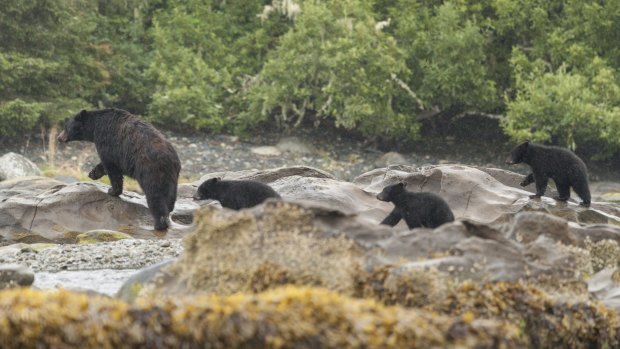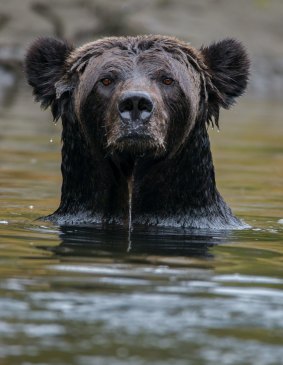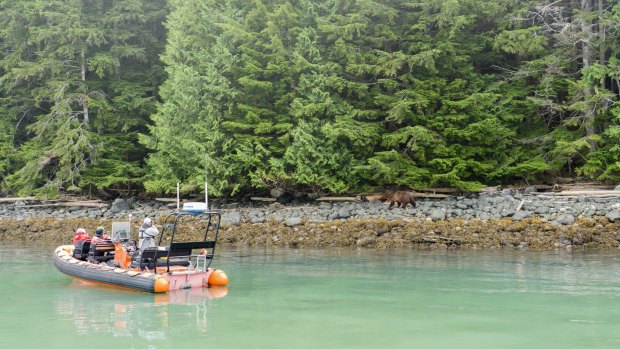By Ute Junker

The Great Bear Rainforest is one of the best places on Earth to spot bears in the wild.Credit: Northern Vancouver Island Tourism/Steven Fines
A grizzly bear safari is not like any other safari. When you are hoping to get close to wildlife, the general rule is to keep quiet so as not to spook the animals. When you are headed into the forest on foot, however, armed only with your cameras and hoping for an encounter with a wild grizzly, it's best not to be too quiet. You don't want to catch a bear unawares, because a startled bear is an angry bear.
Despite that, the deeper we walk into this forest, the quieter we get. Surrounded by soaring trees that filter the soft light falling onto the thick carpet of moss beneath our feet, an air of quiet reverence descends. This forest, you can't help sensing, is a special place.
The Great Bear Rainforest is one of Canada's natural wonders. Spanning 6.4 million hectares of British Columbia's coast – making it about the same size as Ireland – this old-growth rainforest is a place where bears and wolves still roam free, and one of the best places on earth to spot bears in the wild.

Bears are more active in cooler weather. Credit: Destination BC/William Drumm
It's good bear-spotting weather today, with the rain falling lightly but steadily – bears are more active when it's cooler. We follow our guide through the trees to a stretch of coast where bear are often spotted at this time of year, eating their fill of the salmon that thrive in these waters. When we reach the river, however, there's not a bear in sight. We wander along the rushing water for a little until our guide Mike Willie calls it. "Let's try something else," he says.
Returning to our waiting boat, we head back out into the bays and inlets carved into the coast of Vancouver Island. Willie, the owner of Sea Wolf Adventures and a member of the Indigenous Kwikwasut'inuxw Haxwa'mis people, knows this area well and has an almost sixth sense for wildlife. When he slows and then cuts the motor, it takes us a moment to see the animal he has singled out in this vast landscape – a solid grizzly bear grazing along the shoreline, rolling over rocks with its paws, crunching on the crabs and other goodies it finds beneath.
Our bear spottings – yes, we find more later that afternoon – are not the day's only highlight. When we left Port McNeill on the northern coast of Vancouver Island this morning, we had no idea that we would spot porpoises and sea lions, cavorting humpbacks and dozens of sea otters casually hanging out.

Cruising the bays and inlets carved into the coast of Vancouver Island. Credit: Indigenous Tourism BC/Sea Wolf Adventures
Just as entrancing as the wildlife are the tales that Willie shares of his people, particularly their increasing involvement in managing the local eco-system.
"We have been campaigning for years to get rid of the salmon farms," Willie tells us. The salmon are the keystone species that keeps the ecosystem alive, and wild salmon numbers were declining in part due to parasites that infested the farms and passed from there to migrating wild salmon. "Since the farms started being removed, the numbers of wild salmon are increasing."
Indigenous participation in land and water management isn't just helping the environment, however – it is also helping the people. The sense of agency that comes from protecting the environment and from sharing that environment with tourists "helps us break out of the cycle of being stuck in trauma. It inspires new generations of entrepreneurs," Willie says.
Canada's past treatment of its First Nations has much in common with Australia's history, including removing children from their families and the attempted extinction of Indigenous culture. Just as in Australia, Indigenous tourism is offering a chance to forge connections, and British Columbia's tribal peoples are stepping up to share their perspectives on their lands and their history. Vancouver Island's Indigenous operators are boosting local economies and building resilience in the process.
"Being connected to language, to culture, to tradition, to history, brings motivation, it brings confidence," says JP Obbagy. The tourism development officer for Homalco Tours based at Campbell River, Obbagy says he has watched people working in Indigenous tourism "become more than they could ever have imagined themselves to be."
Obbagy has helped Homalco Tours extend its operation from grizzly viewing cruises, operating just two and a half months of each year, to a range of programs operating across most of the year, including a People, Water, Land tour that blends wildlife and culture.
Guests are taken by boat to the last Homalco village - closed in the mid-1980s - by Homalco guides who spent their childhood here and share their experiences. The Homalco are hoping to develop the site to allow for further activities, including building a cultural centre where events such as drumming sessions and traditional salmon bakes are held.
Developing tours can be a complex process, particularly when it comes to striking a balance between truth-telling and delivering a positive experience. "We had a lot of conversations about how to do these tours," says Obbagy. "There is still a lot of anger and it is not going away, and we don't want to sugar-coat the past. But projecting that onto guests is not going to achieve anything."
The experience can be confronting for the guides as well as for guests. "Everyone has their own comfort levels, so we don't press. Some people are comfortable talking about residential schools, others are so traumatised that it triggers them. We focus on the path to recovery, looking at who we were, and this is where we are headed."
First Nations experiences are also available in Vancouver Island's compact capital, Victoria. Information panels that line the harbour foreshore recount the area's Indigenous history but for those wanting to learn more, Explore Songhees Tours offers walking tours and a paddle tour in the harbour, which we join one sunny afternoon.
"It is so powerful to be able to tell our stories on our own land," says Cecilia Dick, cultural tourism manager for the Songhees Nation. Together with her fellow guides, Dick shares stories of how the Songhees lived before the Europeans arrived, and how they carved canoes from a single tree. War canoes were narrow and high, built for speed; trading canoes and passenger canoes were wider, designed to carry large loads.
Our tour includes the opportunity to jump into a replica war canoe (made of fibreglass rather than timber) and start paddling out. Surprisingly quickly, we find our rhythm, pulling up on the opposite shore and explore some areas significant to the Songhees before heading back to the harbour.
"You always had to sing your way in, to let the waiting people know you were friendly," Dick says. She and her colleagues raise their voices in an ancient Songhees melody. As the words drift across the water, they seem to carry a message of survival and of hope.
Ute Junker was a guest of Destination Canada and Destination British Columbia.
THE DETAILS
MORE
FLY
Air Canada has direct daily flights from Sydney to Vancouver, with connecting flights to Melbourne. Transfers to Vancouver Island are available by ferry or by the indigenous-owned Gulf Island Seaplanes. See aircanada.com gulfislandseaplanes.com
STAY
The interiors of the indigenous-owned Kwa'lilas Hotel in Port Hardy are decorated with art by the Gwa'sala-'Nakwaxda'xw people. From $328, see kwalilashotel.com
Sign up for the Traveller Deals newsletter
Get exclusive travel deals delivered straight to your inbox. Sign up now.